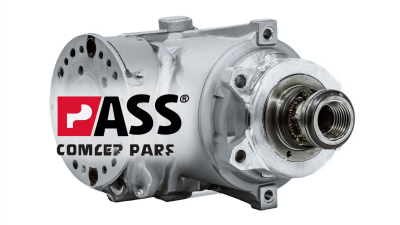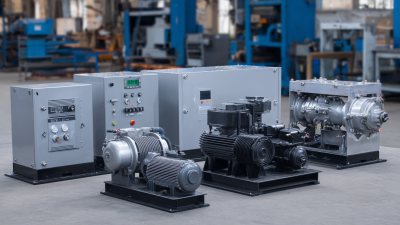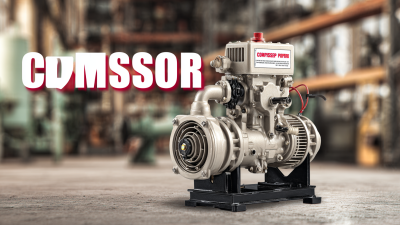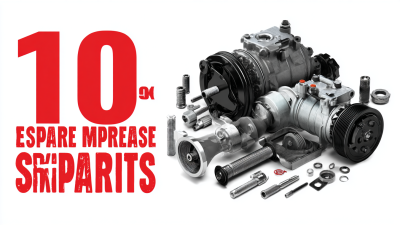Maximizing Efficiency: A Comprehensive Guide to Selecting the Best Screw Compressor Parts
In the realm of industrial machinery, screw compressors have emerged as critical components for a wide array of applications, from manufacturing to oil and gas extraction. Maximizing efficiency through the careful selection of screw compressor parts is paramount for maintaining optimal performance and reducing lifecycle costs. According to a recent study by the International Compressor Engineering Society, the right parts can enhance compressor efficiency by up to 25%, significantly impacting operational productivity.
Industry expert Dr. John Smith, a leading authority in screw compressor technology, emphasizes the importance of component selection, stating, “The efficiency and longevity of a screw compressor are directly influenced by the quality and compatibility of its parts.” This insight highlights the necessity for operators and maintenance teams to prioritize the procurement of high-quality screw compressor parts that not only fit well but also adhere to the latest industry standards.
As businesses strive for sustainability and cost savings, a comprehensive understanding of screw compressor components becomes essential. This guide aims to provide detailed insights into selecting the best screw compressor parts, ensuring that users can achieve enhanced operational efficiency and prolong their equipment's lifespan.

Understanding Screw Compressor Components: Key Elements to Consider
When it comes to maximizing efficiency in screw compressors, understanding the key components is crucial. Screw compressors primarily consist of rotors, bearings, seals, and drive systems. Each element plays a significant role in the overall performance and longevity of the compressor. For instance, the choice of rotor profile impacts the volumetric efficiency directly; reports indicate that rotors with optimized profiles can enhance efficiency by 5-10% compared to traditional designs.
Bearings also warrant attention, as they heavily influence operational reliability and maintenance costs. The use of high-quality materials, such as ceramic or advanced composites, can significantly reduce friction and wear, extending the compressor's lifespan. According to the International Compressor Engineering Conference, integrating advanced bearing technologies can improve energy efficiency by an additional 3-7%. Moreover, seals must be robust and resistant to wear, as they are essential in preventing leaks and maintaining pressure. It's evident that understanding and selecting the right parts based on their specifications and performance can lead to substantial operational savings and efficiency gains.
Maximizing Efficiency: A Comprehensive Guide to Selecting the Best Screw Compressor Parts
| Component | Material | Function | Expected Life Span (Years) | Maintenance Frequency (Months) |
|---|---|---|---|---|
| Rotor | High Alloy Steel | Compression of Air | 10-15 | 12 |
| Bearing | Bronze/Steel | Rotational Support | 5-10 | 6 |
| Oil Separator | Aluminum | Removes Oil from Compressed Air | 7-12 | 12 |
| Air Filter | Synthetic Fiber | Filters Air Inlet | 1-3 | 3 |
| Cooling System | Copper/Aluminum | Maintains Operating Temperature | 10-20 | 12 |
Evaluating Performance Ratings: Selecting Efficient Compressor Parts
When selecting efficient compressor parts, it is crucial to evaluate performance ratings thoroughly. Just as HVAC experts assess mini split brands based on reliability and cost-effectiveness, a similar approach should be taken when considering screw compressor components. Look for parts that not only boast high performance but also maintain durability under heavy usage. This can significantly impact the overall efficiency of your compressor system.
Additionally, when testing air compressors with various tools, understanding how different components contribute to performance can offer valuable insights. This hands-on evaluation can help identify which parts excel and which fall short, ensuring that you invest in components that will enhance your workshop or garage's overall productivity. By focusing on concrete performance metrics, you can make informed decisions that will maximize the efficiency of your compressor system.
Maximizing Efficiency: Performance Ratings of Screw Compressor Parts
Material Selection for Durability: Essential Factors in Component Choice
When selecting components for screw compressors, durability is paramount. The choice of materials significantly influences the longevity and efficiency of the compressor. Key factors to consider include corrosion resistance, wear resistance, and thermal stability. Components made from high-quality alloys or treated metals can withstand harsh operational conditions, reducing the frequency of replacements and maintenance.
**Tip:** Always opt for materials that are specifically designed for the operating environment of your compressor. For instance, stainless steel or specialized coatings may be necessary for applications involving humidity or corrosive elements.
Additionally, consider the specific loads and stresses the components will face. Materials that can handle high stress levels without deforming or failing are crucial for maintaining the operational integrity of the compressor. Testing the material under simulated real-world conditions can provide insights into its suitability for your application.
**Tip:** Look for suppliers that provide detailed material specifications and test results, ensuring transparency in performance and durability. Doing so can help you make informed decisions that enhance the reliability of your screw compressor.
Cost vs. Quality: Finding the Right Balance for Compressor Parts
When selecting screw compressor parts, finding the right balance between cost and quality is vital for ensuring optimal performance and longevity. Low-cost components may seem appealing initially; however, they can lead to increased maintenance costs, frequent replacements, and reduced efficiency. Investing in high-quality parts may require a higher upfront expenditure but can result in significant savings over time through improved reliability and operational efficiency.
To achieve the best results, it's essential to assess the specific needs of your compressor system. Researching manufacturers and reading reviews can help identify reputable suppliers who offer components that meet both quality and budgetary requirements. Additionally, consider the long-term implications of your choices; selecting durable parts can minimize downtime and enhance overall productivity. By prioritizing quality without neglecting cost, you can ensure that your compressor operates at peak performance while maintaining a manageable budget.
Maintenance Requirements: Enhancing Longevity of Screw Compressor Components
The reliability and longevity of screw compressor components heavily depend on their maintenance requirements. Regular inspections, proper lubrication, and timely replacement of worn-out parts are essential practices that significantly enhance the operational lifespan of these machines. A proactive maintenance schedule not only ensures optimal performance but also reduces the risk of unexpected failures that could lead to costly downtime.
In addition, understanding the specific needs of each component plays a crucial role in effective maintenance. For instance, air filters must be replaced regularly to prevent contaminants from entering the system, while seals and gaskets require periodic checks to avoid leaks. By prioritizing these maintenance practices, operators can maximize efficiency and uphold the integrity of their screw compressors amidst growing demand, particularly in rapidly expanding markets like the automotive and breathing air sectors. This attention to maintenance ultimately contributes to both performance and profitability in an increasingly competitive landscape.
Related Posts
-

5 Reasons Best Screw Compressor Parts Enhance Your Operational Efficiency
-

5 Best Screw Compressor Parts You Should Invest In
-

7 Essential Screw Compressor Parts You Need for Optimal Performance
-

Unlocking the Power of Air Compressors: A Comprehensive Guide to Their Applications and Benefits
-

The Ultimate Guide to Selecting the Best Compressor Pumps: Industry Insights and Expert Tips
-

10 Essential Tips for Choosing the Best Air Compressor Spare Parts


